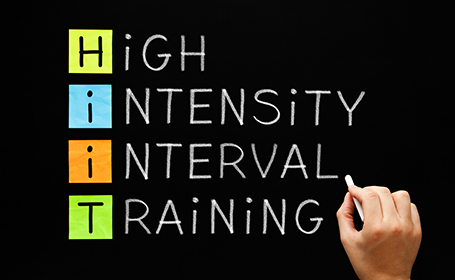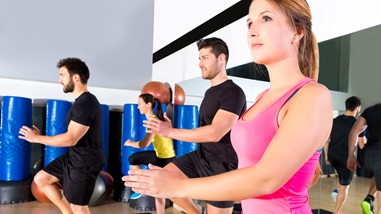
10 benefits of high-intensity interval training (HIIT)
Want to get fitter, healthier and lose weight? Here's why high-intensity interval training (HIIT) could help improve your fitness and your health
Plus, it boosts the cardiorespiratory system, which keeps the blood pumping around your body efficiently in order to fuel your organs with oxygen.
HIIT stands for high-intensity interval training, which is a popular and highly effective form of cardiovascular exercise. HIIT workouts involve short bursts of intense physical activity followed by brief periods of rest or lower-intensity exercise.
High-intensity interval training (HIIT) is a method of exercising that involves short, fast bursts of exercise interspersed with periods of rest. It has been praised for its numerous health benefits and it can help you to get in shape quickly.
Here are 10 benefits of incorporating HIIT into your fitness regime.
1. It improves your stamina
HIIT involves short bursts of intense exercise followed by brief periods of rest or lower-intensity exercise. During the high-intensity intervals, your heart rate and breathing rate increase substantially.
Over time, this helps to improve your aerobic capacity, also known as VO2 max, which is the maximum amount of oxygen your body can use during intense exercise. A higher VO2 max is associated with improved stamina and endurance.
2. It increases your strength
Anaerobic exercise has a tendency to make a person lose muscle as well as fat. HIIT, on the other hand, is proven to maintain muscle by training them to recover and rebuild themselves during the short period of rest.
This helps to build strength quickly and is easily maintained by simply continuing with the HIIT regime.
3. You’ll burns lots of fat during your workout
HIIT is renowned for burning lots of calories and fat. In fact, it reportedly burns 13 calories per minute by pushing the body to meet the demands of the heart’s maximum rate.
Opting for this type of training is great for those looking to lose fat, but should be balanced with a healthy diet that provides enough calories for sufficient fuel.
4. Your body will burn fat after your workout
Not only does HIIT burn lots of calories during the exercise itself, the fast programme increases a person’s resting metabolic rate. This means that the body will continue to burn calories after the workout has finished, making managing calorie intake much easier.
This is often referred to as the "afterburn effect" or excess post-exercise oxygen consumption (EPOC). EPOC occurs because your body needs to restore oxygen levels, remove waste products, and repair muscle tissue after intense exercise. This process requires additional energy and can last for hours or even days after a HIIT session.
HIIT has a positive impact on your heart health by helping prevent a variety of cardiac diseases. It can even reverse some of the symptoms of stable coronary artery disease.
5. It keeps your heart healthy
Stable coronary artery disease is often described as clogging of arteries which can lead to heart attacks. A healthy diet and exercise is essential for preventing this build-up of plaque.
Studies by The National Library of Medicine show that HIIT has a positive impact on your heart health by helping prevent a variety of cardiac disease. It can even reverse some of the symptoms of stable coronary artery disease.
6. It keeps you younger
The human growth hormone, HGH, is produced by the body during childhood and adolescence to help a person grow and develop into adulthood.
During HIIT, the production of the hormone is stimulated, which in turn increases hair and nail growth. So not only will HIIT help to keep you in shape, but you’ll maintain a youthful look, too.

7. It’s fast and therefore relieves stress
As well as being over quickly (a definite plus for those who aren’t keen on cardio exercise), it also means that it can be incorporated into a busy schedule.
Plus, it requires the utmost concentration to maintain the high intensity levels. This distracts the brain from worrying about the stresses and concerns of everyday life, helping the mind to relax.
8. It can help to strengthen your bones
A lot of HIIT training can be done almost anywhere, so you can use the opportunity to get some fresh air. By exercising outside, the skin can absorb vital vitamin D from the sun, which helps to maintain healthy bones and teeth.
HIIT can improve insulin sensitivity, which is the body's ability to respond to insulin and regulate blood sugar effectively.
9. It can help regulate your blood sugar levels
HIIT can improve insulin sensitivity, which is the body's ability to respond to insulin and regulate blood sugar effectively. During high-intensity intervals in a HIIT workout, your muscles require more glucose for energy. To meet this demand, your body becomes more sensitive to insulin, allowing glucose to enter the cells more efficiently. This enhanced sensitivity can help lower blood sugar levels and reduce the risk of insulin resistance, a key factor in type 2 diabetes.
HIIT can also help lower post-meal blood sugar spikes. After a meal, blood sugar levels typically rise. HIIT, particularly when performed after a meal, can assist in reducing the magnitude of this post-meal blood sugar increase.
10. It eases muscle stiffness
Studies by The National Library of Medicine show that disease sufferers found that after eight weeks of HIIT, the participants’ muscles were less rigid and much more comfortable. This indicates that HIIT could relieve that stiff feeling a lot of people feel in the morning or after long periods of sitting or standing.
If you are suffering with an injury, always consult a physiotherapist or sports injury clinic before starting high-intensity interval training.
Everything you need to know about maintaining a healthy, balanced lifestyle
Tags
How do I book an appointment?
If you're concerned about symptoms you're experiencing or require further information on this subject, talk to a GP or see an expert consultant at your local Circle Hospital.